Inscriptions, texts nos. 80-97 - The Balawat Gates
Browse the RIA 4 Corpus [/riao/ria4/pager/]
80 81 82 83 84 85 86 87 88 89 90 91 92 93 94 95 96 97
80
A bronze band bears the following epigraph: "Booty from Sangara, a man of Ḫatti". The text is well preserved and its mention of Sangara means that the object can be linked to Aššurnasirpal II's encounter with that individual at Carchemish as described in text no. 1 [/riao/ria4/Q004455/] iii 65-69. See also text no. 90. The band itself was discovered at Imgur-Enlil (see text no. 51) and is currently housed in the British Museum.
Access the composite text [/riao/ria4/Q004534/] of Ashurnasirpal II 80.
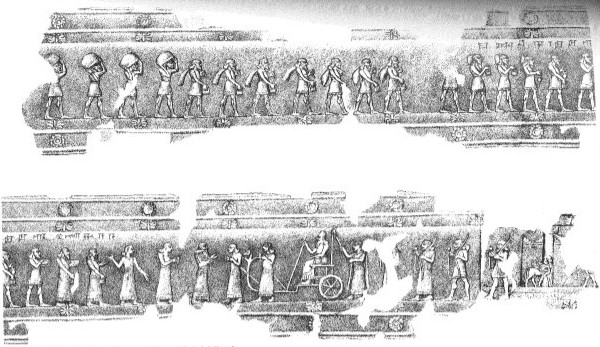
2008 Curtis and Tallis (eds), The Balawat Gates of Ashurnasirpal II Fig. 18 p. 119
Bibliography
81
A bronze band bears the following epigraph: "Battle against the city Marinâ of Bīt-Adini". The city mentioned, Marinâ, is unknown. However, other cities of Bīt-Adini are mentioned in text nos. 86 and 87. Aššurnasirpal II's involvement with Bīt-Adini is described in text no. 1 [/riao/ria4/Q004455/] iii 41-43, 50-56, and 60-64. The band itself was discovered at Imgur-Enlil (see text no. 51) and is currently housed in the British Museum.
Access the composite text [/riao/ria4/Q004535/] of Ashurnasirpal II 81.
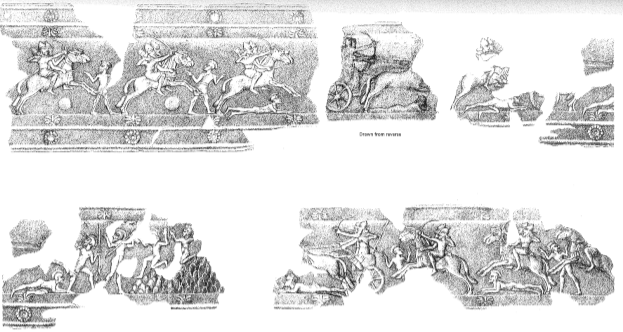
2008 Curtis and Tallis (eds), The Balawat Gates of Ashurnasirpal II Fig. 10 p. 111
Bibliography
82
A bronze band bears the following epigraph: "Palace of Ashurnasirpal, king of the world, king of Assyria, son of Tukultī-Ninurta (II), king of Assyria, son of Adad-nārārī (II) (who was) also king of Assyria: booty from the city Ellipu of the land Ḫat[te]". The city name, El(l)ipu is not attested in Assyrian royal inscriptions before this reign. The city of the same name-- located in the east-- which is mentioned in texts from the Sargonid period is almost certainly not that same place. The band itself was discovered at Imgur-Enlil (see text no. 51) and is currently housed in the British Museum.
Access the composite text [/riao/ria4/Q004536/] of Ashurnasirpal II 82.
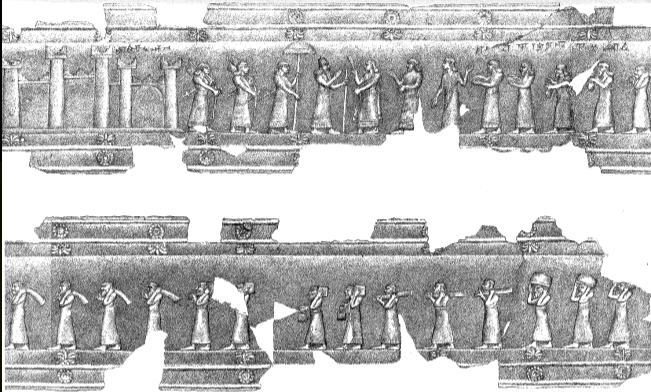
2008 Curtis and Tallis (eds), The Balawat Gates of Ashurnasirpal II Fig. 24 p. 125
Bibliography
83
A bronze band bears the following epigraph: "The city [Magar]isu of Bīt-Iaḫiri I conquered". Text no. 1 [/riao/ria4/Q004455/] (ii 21-22) mentions an individual from Bīt-Iaḫiri, named Aḫi-ramu, giving tribute to Aššurnasirpal II. The name of the city mentioned here does not survive, however, nor does it seem to be given in text no. 1 [/riao/ria4/Q004455/]. It is possibly Magarisu (as mentioned in text no. 1 [/riao/ria4/Q004455/] iii 3), but this is unclear. The band itself was discovered at Imgur-Enlil (see text no. 51) and is currently housed in the British Museum.
Access the composite text [/riao/ria4/Q004537/] of Ashurnasirpal II 83.
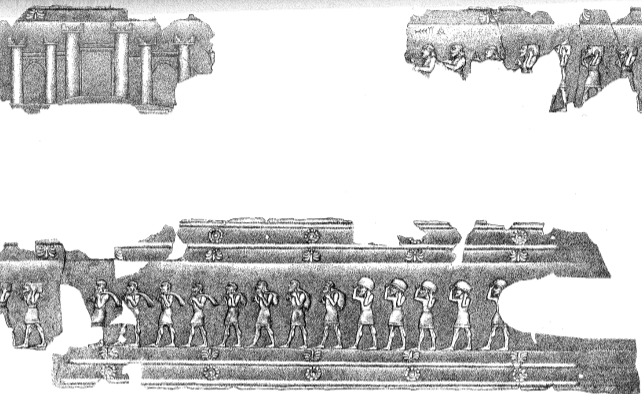
2008 Curtis and Tallis (eds), The Balawat Gates of Ashurnasirpal II Fig. 28 p. 129
Bibliography
84
A bronze band bears the following epigraph: "Payment from the people of the city Sarugu". The name of the city, Sarugu, is not attested in the inscriptions of Aššurnasirpal II. It is possible that it refers to a city of that name located close to Harran. Alternatively it may be linked to the city Saraku in Hanigalbat as mentioned in the royal inscriptions of Adad-nārārī II [/riao//ria3/adadnarariii/index.html] (see text no. 2 [/riao/ria4/Q006021/], lines 42-44). The band itself was discovered at Imgur-Enlil (see text no. 51) and is currently housed in the British Museum.
Access the composite text [/riao/ria4/Q004538/] of Ashurnasirpal II 84.
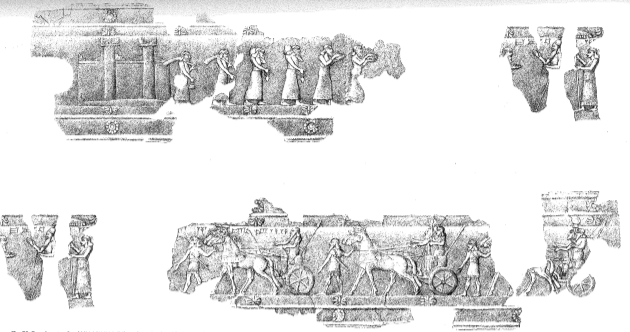
2008 Curtis and Tallis (eds), The Balawat Gates of Ashurnasirpal II Fig. 8 p. 109
Bibliography
85
A bronze band bears the following epigraph: "Palace of Ashurnasirpal, king of the world, king of Assyria, son of Tukultī-Ninurta (II), king of Assyria, son of Adad-nārārī (II) (who was) also king of Assyria: plunder from the land Ḫatti". It gives a brief genealogy of Aššurnasirpal II and states that he plundered the land of Ḫatti. A more precise location is not given. The band itself was discovered at Imgur-Enlil (see text no. 51) and is currently housed in the British Museum.
Access the composite text [/riao/ria4/Q004539/] of Ashurnasirpal II 85.
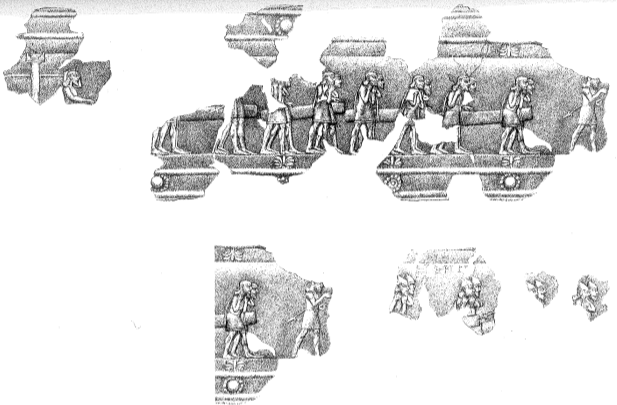
2008 Curtis and Tallis (eds), The Balawat Gates of Ashurnasirpal II Fig. 22 p. 123
Bibliography
86
A bronze band bears the following epigraph: " Palace of [Ashurnasir]pal, king of the world, [king of Assyria, son of Tukultī-Ninurta (II), king of Assyria], son of Adad-nārārī (II) (who was) also king of Assyria: the city Rugulutu of Bīt-Adini I conquered". For more on Bīt-Adini and its corresponding cities see the introduction to text no. 81. The band itself was discovered at Imgur-Enlil (see text no. 51) and is currently housed in the British Museum.
Access the composite text [/riao/ria4/Q004540/] of Ashurnasirpal II 86.
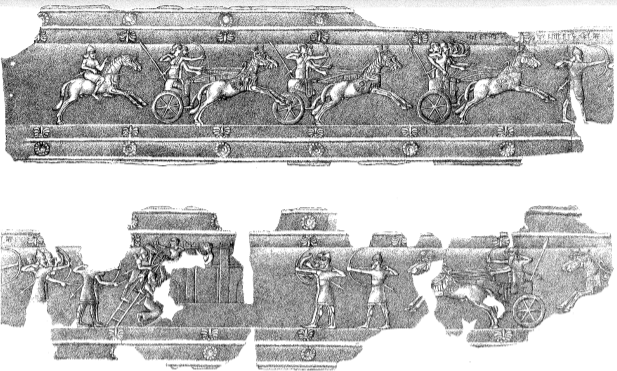
2008 Curtis and Tallis (eds), The Balawat Gates of Ashurnasirpal II Fig. 26 p. 127
Bibliography
87
A bronze band bears the following epigraph: "The city I[all]gu [of Bīt]-Adini I conquered". For more on Bīt-Adini and its corresponding cities see the introduction to text no. 81. The band itself was discovered at Imgur-Enlil (see text no. 51) and is currently housed in the British Museum.
Access the composite text [/riao/ria4/Q004541/] of Ashurnasirpal II 87.
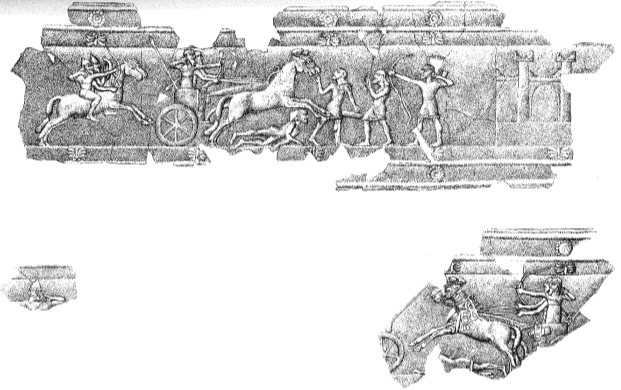
2008 Curtis and Tallis (eds), The Balawat Gates of Ashurnasirpal II Fig. 20 p. 121
Bibliography
88
A bronze band bears the following epigraph: "Palace of Ashurnasirpal, king of the world, king of Assyria, son of Tukultī-Ninurta (II), king of Assyria, son of Adad-nārārī (II) (who was) also king of Assyria: tribute from the land Sūḫu". The text commemorates the payment of tribute from the land Suḫu, which is also mentioned in text no. 1 [/riao/ria4/Q004455/] (i 99-100). See also iii 26-38 of the same text and text no. 97 for further mention of Suḫu. The band itself was discovered at Imgur-Enlil (see text no. 51) and is currently housed in the British Museum.
Access the composite text [/riao/ria4/Q004542/] of Ashurnasirpal II 88.
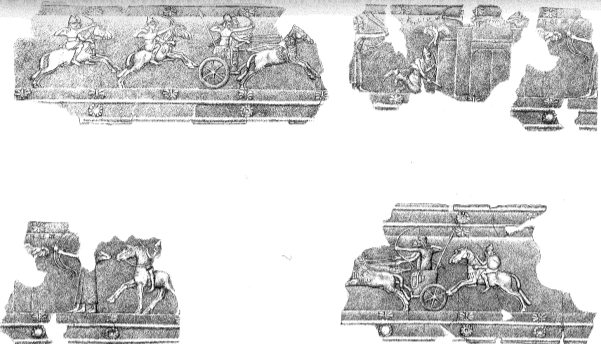
2008 Curtis and Tallis (eds), The Balawat Gates of Ashurnasirpal II Fig. 36 p. 137
Bibliography
89
A bronze band bears the following epigraph: "Tribute from the city [...]ga[...]". The city name is not preserved. The band itself was discovered at Imgur-Enlil (see text no. 51) and is currently housed in the British Museum.
Access the composite text [/riao/ria4/Q004543/] of Ashurnasirpal II 89.
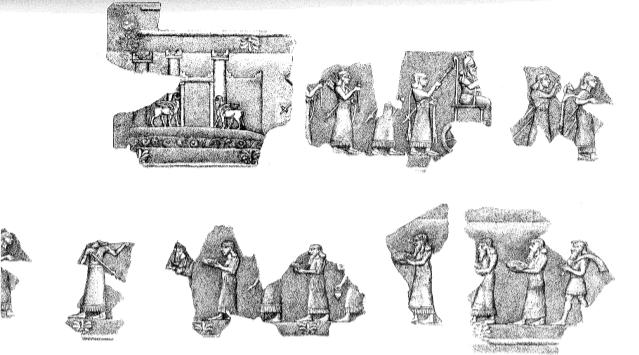
2008 Curtis and Tallis (eds), The Balawat Gates of Ashurnasirpal II Fig. 34 p. 135
Bibliography
90
A bronze band bears the following epigraph: "The city Ulluba of Sagara, [king of] the land Ḫatti, I conquered". It seems probable that the individual mentioned in this text is to be identified with the king of Ḫatti mentioned in text no. 1 [/riao/ria4/Q004455/] (iii 65-68) (see also text no. 80). The city Ulluba may be connected to the city Ulliba mentioned in text no. 19 [/riao/ria4/Q004473/], line 90. If so, it is located in the region of the Upper Tigris. The band itself was discovered at Imgur-Enlil (see text no. 51) and is currently housed in the British Museum.
Access the composite text [/riao/ria4/Q004544/] of Ashurnasirpal II 90.
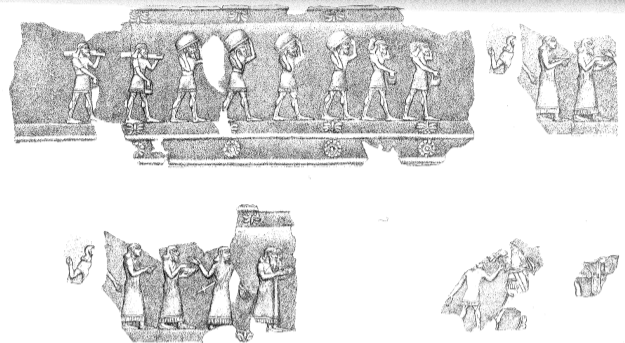
2008 Curtis and Tallis (eds), The Balawat Gates of Ashurnasirpal II Fig. 12 p. 113
Bibliography
91
A bronze band bears the following epigraph: "Palace of Ashurnasirpal, king of the world, king of Assyria, son of Tukultī-Ninurta (II), king of Assyria, son of Adad-nārārī (II) (who was) also king of Assyria: plunder from the city Mari[ru] of the land Ḫatti". It is unclear to which city the inscription refers. Grayson suggests the city of Mariru in the region of the Upper Tigris, as mentioned by this monarch in text no. 1 [/riao/ria4/Q004455/] (i 111). It is highly unlikely that the name in question is the Mari located on the Euphrates, as that city name is not used in any other Assyrian royal inscriptions after the late Middle Assyrian period. The epigraph supplies a brief genealogy of Aššurnasirpal II. The band itself was discovered at Imgur-Enlil (see text no. 51) and is currently housed in the British Museum.
Access the composite text [/riao/ria4/Q004545/] of Ashurnasirpal II 91.
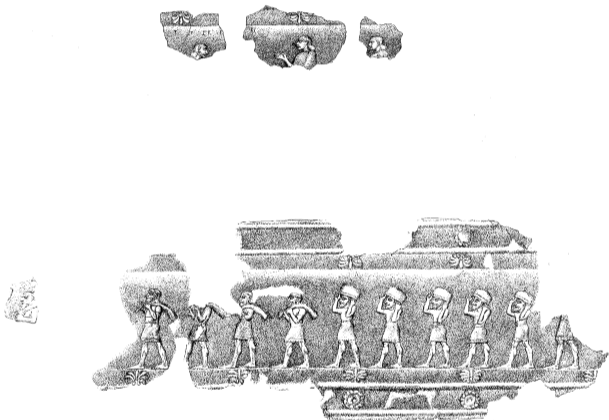
2008 Curtis and Tallis (eds), The Balawat Gates of Ashurnasirpal II Fig. 38 p. 139
Bibliography
92
A bronze band bears the following epigraph: "I slew wild oxen on the Euphrates". The band itself was discovered --along with many others-- at Imgur-Enlil (see text no. 51) and is currently housed in the British Museum.
Access the composite text [/riao/ria4/Q004546/] of Ashurnasirpal II 92.
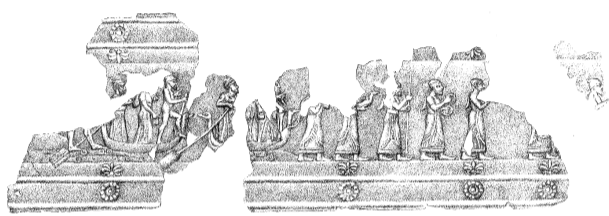
2008 Curtis and Tallis (eds), The Balawat Gates of Ashurnasirpal II Fig. 13 p. 114
Bibliography
93
A bronze band bears the following epigraph: "I slew lions on the River Baliḫ". The band itself was discovered --along with many others-- at Imgur-Enlil (see text no. 51) and is currently housed in the British Museum.
Access the composite text [/riao/ria4/Q004547/] of Ashurnasirpal II 93.
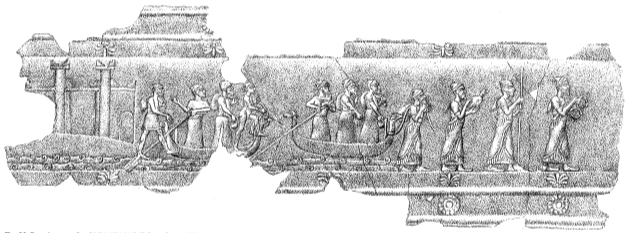
2008 Curtis and Tallis (eds), The Balawat Gates of Ashurnasirpal II Fig. 16 p. 117
Bibliography
94
A bronze band bears the following epigraph: "Palace of Ashurnasirpal, king of the world, king of [Assyria], son of Tukultī-Ninurta (II), [king of Assyria], son of Adad-nārārī (II) (who was) also king of Assyria: I slew lions on the River Baliḫ". The text gives a brief genealogy of Aššurnasirpal II and pays homage to his killing of lions on the river Baliḫ. The band itself was discovered --along with many others-- at Imgur-Enlil (see text no. 51) and is currently housed in the British Museum.
Access the composite text [/riao/ria4/Q004548/] of Ashurnasirpal II 94.
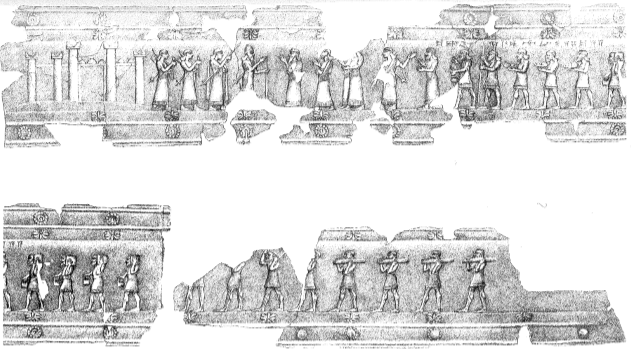
2008 Curtis and Tallis (eds), The Balawat Gates of Ashurnasirpal II Fig. 32 p. 133
Bibliography
95
A bronze band bears the following epigraph: "Palace [of Ashurnasirpal], king of the world, king of Assyria, son of Tukultī-Ninurta (II), king of Assyria, son of Adad-nārārī (II) (who was) also king of [Assyria]: I slew wild oxen on the Euphrates". The text gives a brief genealogy of Aššurnasirpal II and pays homage to his killing of oxen on the Euphrates. The band itself was discovered --along with many others-- at Imgur-Enlil (see text no. 51) and is currently housed in the British Museum.
Access the composite text [/riao/ria4/Q004549/] of Ashurnasirpal II 95.
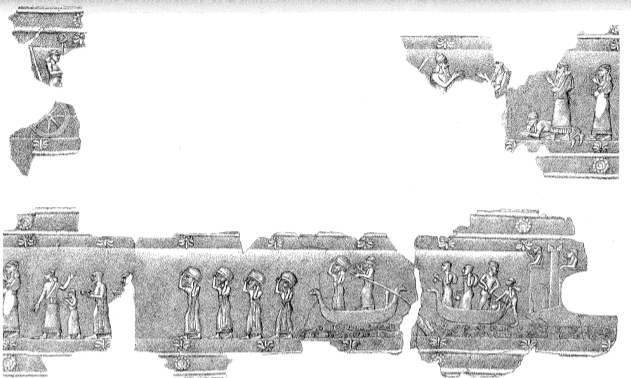
2008 Curtis and Tallis (eds), The Balawat Gates of Ashurnasirpal II Fig. 30 p. 131
Bibliography
96
A bronze band bears the following brief epigraph: "The city Imgur-Enlil". The text mentions Imgur-Enlil, the city at which it was discovered (see text no. 51). It is currently housed in the British Museum.
Access the composite text [/riao/ria4/Q004550/] of Ashurnasirpal II 96.
Bibliography
97
A bronze band bears the following epigraph: "Tribute from Kudurru of the land [Sūḫu]". The text mentions Kudurru (see text no. 1 [/riao/ria4/Q004455/] iii 16-25) and Suḫu (see text no. 88). The band itself was discovered --along with many others-- at Imgur-Enlil (see text no. 51) and is currently housed in the British Museum.
Access the composite text [/riao/ria4/Q004551/] of Ashurnasirpal II 97.
Bibliography
Nathan Morello & Poppy Tushingham
Nathan Morello & Poppy Tushingham, 'Inscriptions, texts nos. 80-97 - The Balawat Gates', RIA 4: Inscriptions of Ashurnasirpal II, The RIA Project, 2023 [http://oracc.org/inscriptions/texts8097/]